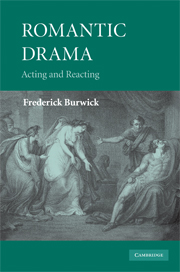Book contents
- Frontmatter
- Contents
- List of illustrations
- Acknowledgments
- Introduction
- 1 Periscopes into the theatre
- 2 Nationalism and national character
- 3 Genre: the realism of fantasy, the fantasy of realism
- 4 Acting: histrionics, and dissimulation
- 5 Transvestites, lovers, monsters: character and sexuality
- 6 Setting: where and elsewhere
- 7 Gothic and anti-Gothic: comedy and horror
- 8 Blue-Beard's castle: mischief and misogyny
- 9 Vampires in kilts
- Notes
- Bibliography
- Index
8 - Blue-Beard's castle: mischief and misogyny
Published online by Cambridge University Press: 04 August 2010
- Frontmatter
- Contents
- List of illustrations
- Acknowledgments
- Introduction
- 1 Periscopes into the theatre
- 2 Nationalism and national character
- 3 Genre: the realism of fantasy, the fantasy of realism
- 4 Acting: histrionics, and dissimulation
- 5 Transvestites, lovers, monsters: character and sexuality
- 6 Setting: where and elsewhere
- 7 Gothic and anti-Gothic: comedy and horror
- 8 Blue-Beard's castle: mischief and misogyny
- 9 Vampires in kilts
- Notes
- Bibliography
- Index
Summary
At odds with the popular concept of “romantic love” is the pervasive presence of misogyny in Romantic drama. Although it has been acknowledged that the Gothic in Romantic literature provided a fictive disguise for exposing issues of domestic abuse of women, little attention has yet been addressed to the presumed rationale for the abuse or for the punishment of the perpetrator. Nor was violence against women a theme confined exclusively to Gothic drama. While some works may have been intended as a moral corrective, others seem to indulge a sadistic male fantasy. Indeed, in some plays the moral retribution in the final scene seems no more than a belated excuse for the sexual fantasy that dominates throughout the preceding scenes. Even the women playwrights (Joanna Baillie, Charlotte Birch-Pfeiffer, Mary Mitford) modulate the relative transparency/opacity of the disguise in depicting male hypocrisy. The representation of a fatal “female curiosity” in the staging of Blue-Beard – in the theatrical versions by Jean Michael Sédaine and André Grétry (1789), Ludwig Tieck (1797), George Colman (1798), William Dunlap (1811), Reginald Heber (1812), and James Robinson Planché (1839) – reveal marked variations in the strategies of sadistic eroticism, displaced culpability, and pretenses of moral rectitude. Although similar patterns of misogyny and disguise could be observed in plays as different as Wordsworth's The Borderers, Lewis' The Castle Spectre, Baillie's Orra, and Shelley's The Cenci, the attention here will be given exclusively to the identity and motives of the blue-bearded villain, to the circumstances of his victim's entrapment, and to the ethical ground of her rescue.
- Type
- Chapter
- Information
- Romantic DramaActing and Reacting, pp. 202 - 229Publisher: Cambridge University PressPrint publication year: 2009



